Every hair removal regime is personal to the individual, and indeed, not everyone will want to do it at all. If, however, you are on the constant quest to be hairless and fancy trying a new method of hair removal, consider this your epilating guide 101. Take a peek at our best epilators list below...
Hair removal has to be the most inconvenient and time-consuming beauty ritual we practise. A study carried out by Escentual.com revealed that women in the UK spend on average 72 days in their lifetime shaving their legs – that’s the equivalent of 1,728 hours. This depressing stat is made even more painful due to the fact that hair removal is considered the most hated beauty chore.
Best epilators at a glance
Best epilator: Braun Silk-épil Series 9 Flex 9-060 3D Epilator - view offer on Braun
Best affordable epilator: Philips Satinelle Essential Compact Epilator - view on Amazon UK
Best epilator for face: Braun Face Mini Hair Remover FS1000 - view on Amazon UK
What is epilating?
Epilating, like waxing, is when you pull the hair out from the root to stunt the regrowth and achieve longer-lasting smoothness. An epilator looks a bit like an electric shaver (and sounds like a lawn mower) but with wheels that spin and a tweezer mechanism that plucks out hair when pressed against the skin.
Unlike laser hair removal, epilation works by gently plucking hair from the root with a series of tweezers, which can grab the smallest of hairs (as short as 0.5mm - the equivalent of two days' growth). Waxing generally tends to grab hairs of 2mm length, so epilation is more precise.
How we chose the best epilators
Below, is the ultimate, authoritative guide to finding the best epilators. Our mission is to help smooth-skin seekers - from first-time users to seasoned at-home waxers. We've found the market’s top-performing models that whisk away hair quickly, minimise pain, reduce irritation and stay effective over years of use. All the while, they will hopefully streamline your beauty routine and cut salon costs. We've spoken to experts, too, for the most useful skin-savvy tips, so you know Grazia has got you covered.
SHOP: The Best Epilators
Best epilator set for easy hair removal
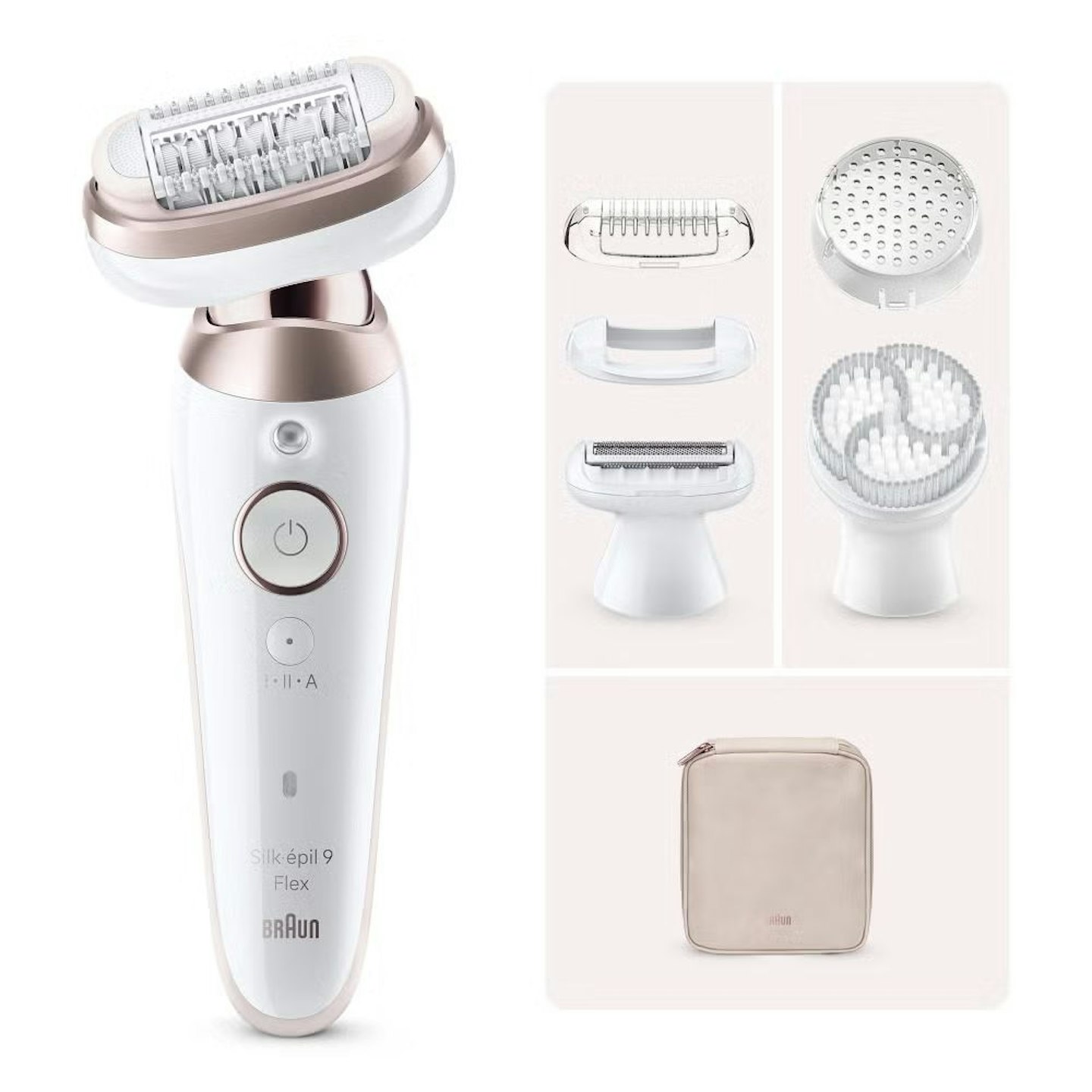 Braun
Braunwww.braunshop.co.uk
Meet the Silk-épil 9 Flex - aka the first epilator with a head that actually bends to your will. Groundbreaking? Yep. Overhyped? Not this time. It’s basically the gold standard of hair removal gadgets, and according to our beauty writer Ruby Barry (who’s been road-testing it for a whole year), it’s the rare beauty tool that still makes the cut long after the honeymoon phase. Her verdict?
"I've never had a good experience using an epilator until I tried the Silk-9. Pulling the hair from the root is never going to be an easy task, but the device is 100% waterproof, which means I can use it in the shower and make it a more relaxing experience.
I use it mainly to shave my legs, and I like how the pivoting head allows me to capture hard-to-reach spots around the back of my ankles. My favourite thing about the epilator is that it comes with a shaver and trimmer head as well as a bikini styler for the more private areas."
Pros
- A flexi head that gets into those sneaky, hard-to-reach spots
- Quiet, powerful, quick-charging and the travel pouch is as handy as it sounds
- 100% waterproof, so shower sessions feel more spa, less torture chamber
- Two power modes and silky-smooth results people can’t stop raving about
Cons
- Comes with a two-pin charger, so you’ll need an adapter (ugh, we know)
- Arrives completely flat, meaning you’ve got to let it charge before you epilate
- Flexible head pivots to tackle tricky areas like knees, ankles, and underarms with ease.
- 40 MicroGrip Tweezers snatch hairs as short as 0.5 mm for ultra-smooth, long-lasting results.
- Wide epilation head covers more skin in one pass, making the process faster without losing precision.
- Two power modes mean you can customise intensity for sensitive zones or go full power when you’re feeling brave.
- Suitable for wet and dry use - it's 100% waterproof, so you can epilate in the shower or bath for extra comfort.
- Precision handle gives an ergonomic grip for better control and maneuverability.
- Extras - includes massage roller cap, lady shaver head, trimmer comb, and bikini styler.
- Exfoliation brushes preps skin before epilation, helping reduce ingrown hairs.
Best affordable epilator
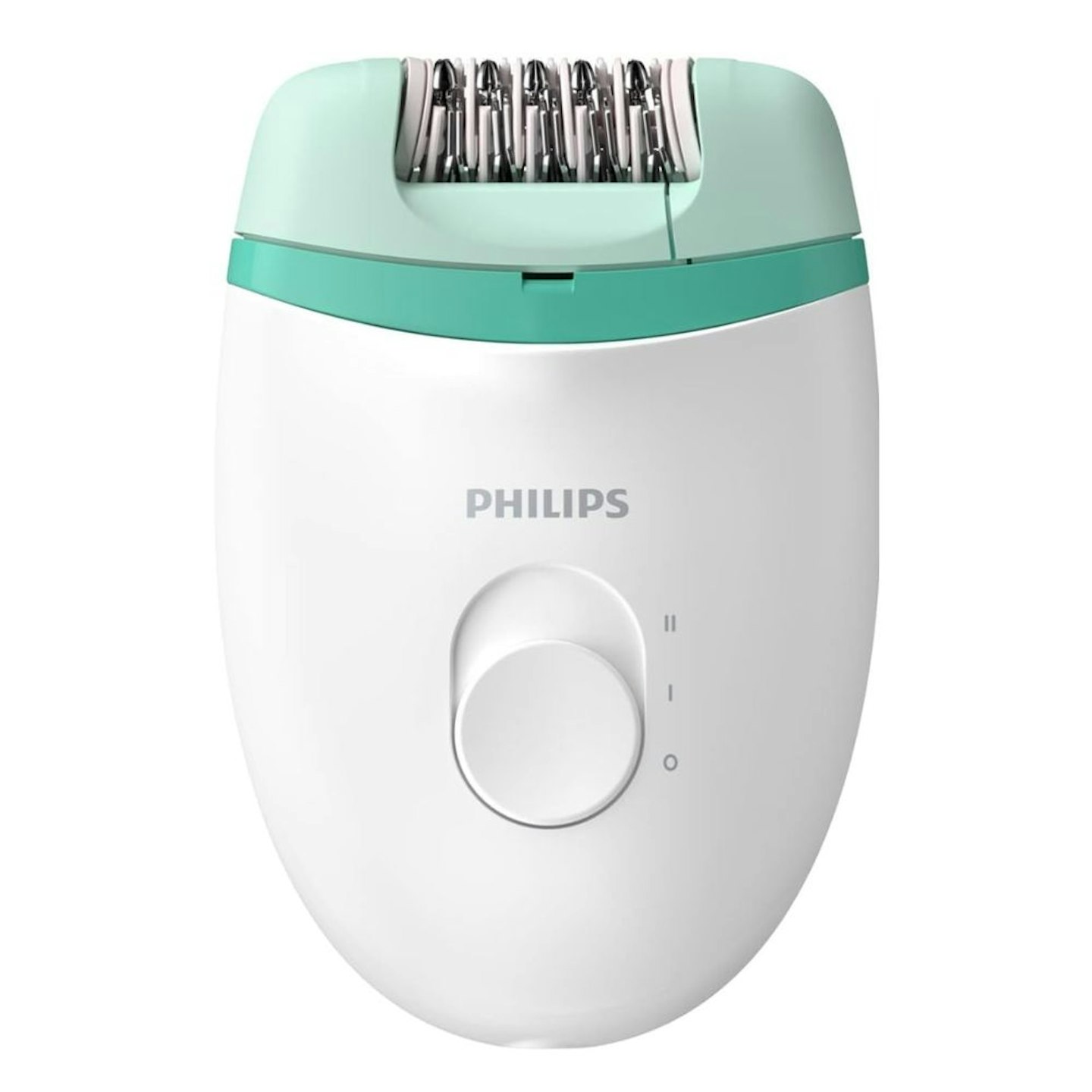 Philips
PhilipsMeet the Philips Satinelle Essential Compact Epilator: the little gadget that punches way above its weight. Small, yes. Mighty? Absolutely. It’ll nab those pesky 0.5mm hairs and keep your legs silky for weeks. And for under £30 (thanks, Amazon), it’s proof you don’t need to splash out big-brand money for smooth results.
If travel epilators aren’t your thing, this one still earns its keep - tiny tweezers make it great for facial fuzz duty, too. Easy to clean (thanks to a detachable head), slim enough to stash in a drawer, and with a cord long enough to move around freely. Philips designed this to be fuss-free and wallet-friendly.
What are people saying? Smoothness that lasts a solid 2–3 weeks, short-hair-catching superpowers, and overall “how is this so affordable?” energy. The flip side: it’s not cordless, it makes a bit of a buzz, and yes, like every epilator ever, it might feel prickly at first. (Beauty is pain, folks.)
Pros
- Two settings for fine or thicker hair (choose your fighter)
- Compact and travel-ready, with a nice long cord
- Actually catches those pesky short hairs other devices don't
- Price point = unbeatable value
Cons
- Corded only - no cordless freedom here
- Primarily made for legs, so it’s not an all-over hero
- Removes hairs from the root = smooth skin for weeks.
- Two speed modes: gentle for soft fuzz, powerful for stubborn strays.
- Compact, ergonomic design that fits right in your hand.
- Washable epilation head - just rinse under the tap.
- Long cord so you’re not chained to an outlet mid-session.
- Comes with a cleaning brush + a 2-year guarantee (because Philips loves a promise).
Best epilator for face
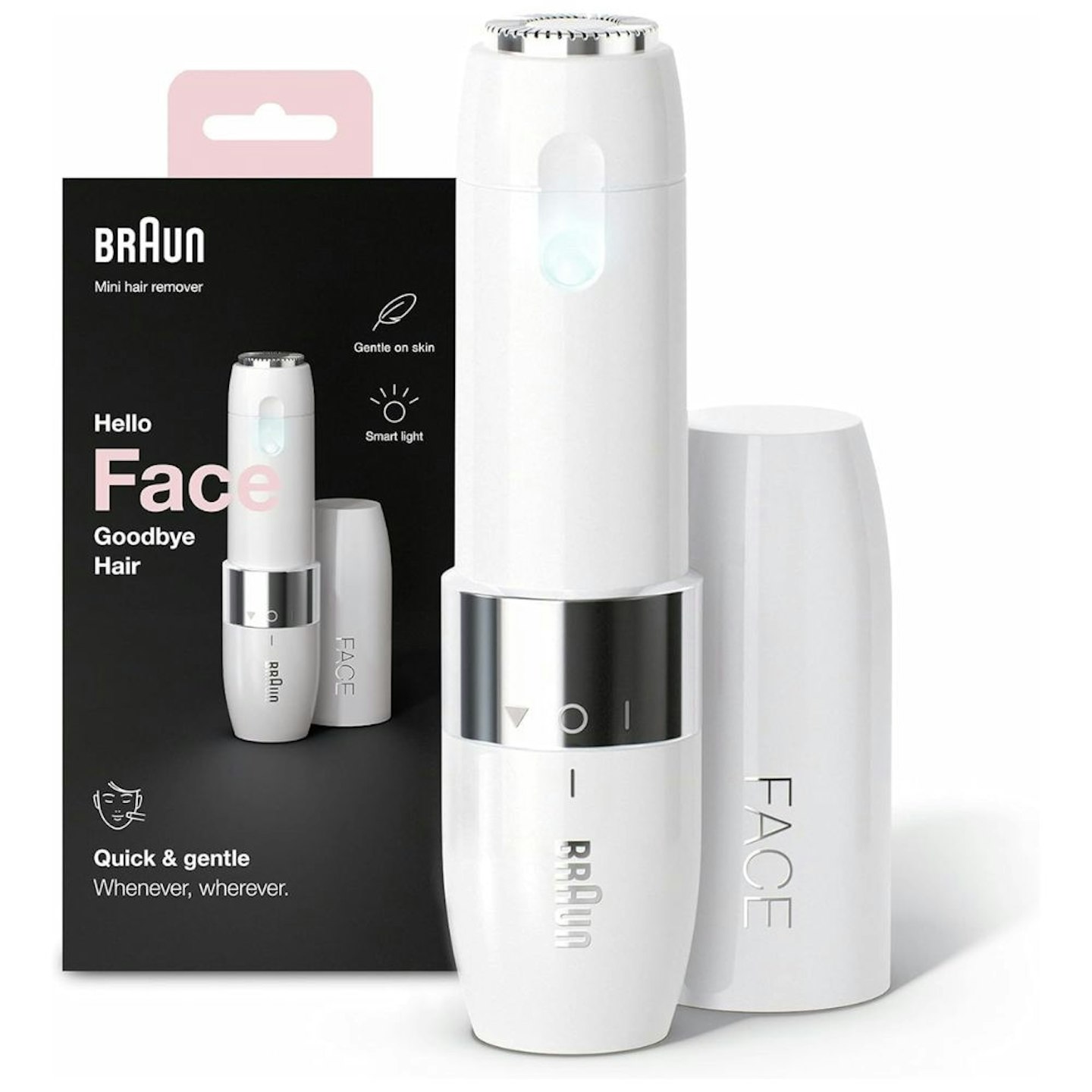 Braun
BraunHunting for the perfect facial hair remover can feel… overwhelming. Enter the Braun Mini Hair Remover. It's small, cordless, and mighty enough to tackle every nook and cranny. Think peach fuzz, sideburns, or those sneaky hairs that always hide. Smooth, fuzz-free skin? Yes, please.
This mini superstar is gentle, thanks to its rotary cutting system with protective foil, so you get good skin-deep results without any redness, irritation and "ouch". Thank goodness. We, personally, love the smart-light feature - it's a little hero, which spots even the tiniest peach fuzz so you don’t miss a single hair. Portable, discreet, and perfect for on-the-go touch-ups. It's a salon in your pocket.
Downsides? Users don't like that it's a dry-only device (no shower shaves) and runs on an AA battery, so you’ll need replacements eventually. Though customers agree that hair may grow back quicker than with larger epilators, the trade-off is a gentle, fuss-free experience that’s perfect for facial fuzz. If you’re over salon trips, waxing, or just want a painless quick fix, this is your new bestie.
Pros
- Compact, portable, and removes fuzz super close to the skin
- Easy to clean and built to last - perfect for the face and delicate areas
- Comes with a shaver head designed just for facial precision
- Smart-light shows every last hair - no fuzz escapes
Cons
- Not washable - must be kept dry
- Requires AA battery replacement eventually
- Only suitable for facial hair
- Gentle rotary cutting system with protective foil for comfort.
- Smart-light to spot even the tiniest hairs.
- Mini, ergonomic design for portability and discreet touch-ups.
- Cordless operation powered by 1 x AA battery (included).
- Suitable for all skin and hair types, including sensitive skin.
- Ergonomic design for easy use on tricky areas.
Best wet and dry epilator
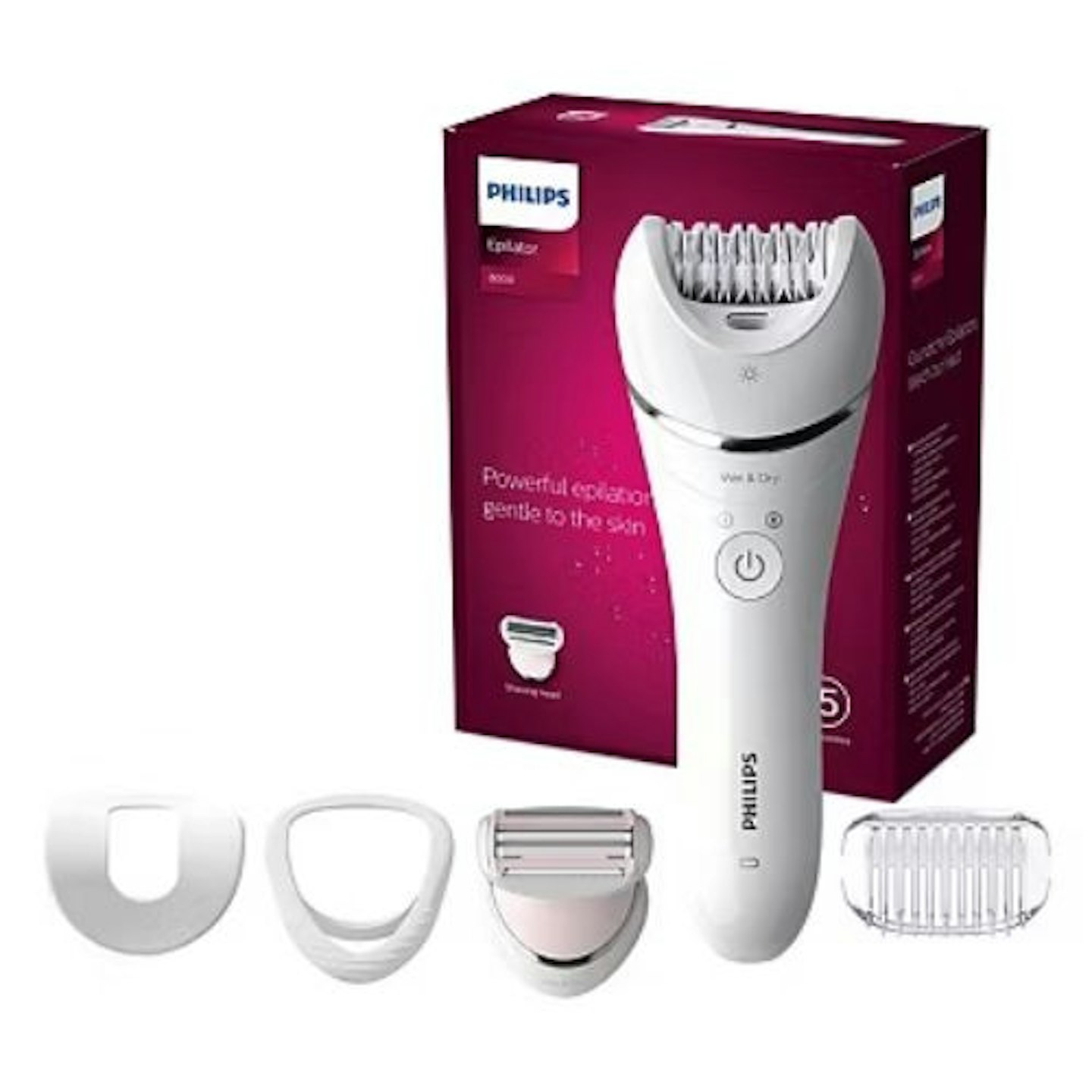 Philips
Philipswww.argos.co.uk
If your shower routine could use a little upgrade, consider the Philips Satinelle Wet & Dry Epilator Series 8000. It promises up to four weeks of smoothness (forget your razor for a while) and works wet or dry. Plus, it’s cordless, lightweight, and comes with a handful of handy attachments. Sure, it feels a bit more plasticky than some Braun models, but it’s bringing plenty to the table.
Now, let’s break down the good, the bad, and the hairy... Users say it leaves legs silky for weeks, feels gentler than older models (read: less pain), and is surprisingly beginner-friendly. The shower option is a game-changer, and its cordless, travel-ready design makes it easy to pack. Most agree it beats waxing on the pain scale. The trade-offs? It’s louder than you’d expect, sometimes misses very fine hairs (especially on the face), and the plasticky build doesn't scream luxury. But if you want convenience, comfort, and long-lasting results, this little Philips delivers. Gorge.
Pros
- Long-lasting smoothness (weeks, not days)
- Gentler than older epilators - less painful and beginner-friendly
- Cordless, ergonomic, and lightweight makes it great for travel
- Shower-friendly with multiple attachments
- Users say it’s less painful than waxing
Cons
- Louder than expected (a.k.a. noisy)
- Doesn’t always grab very short or fine hairs, especially on the face
- Build feels a little plasticky compared to Braun
- Up to 70,000 hair-grabbing actions per minute = fast and efficient.
- Extra-wide head covers more skin in less time.
- Cordless and waterproof, with anti-slip grip for shower/bath use.
- Opti-light to spot fine hairs.
- Ergonomic S-shaped handle for easy maneuvering.
Best epilator for long-lasting results
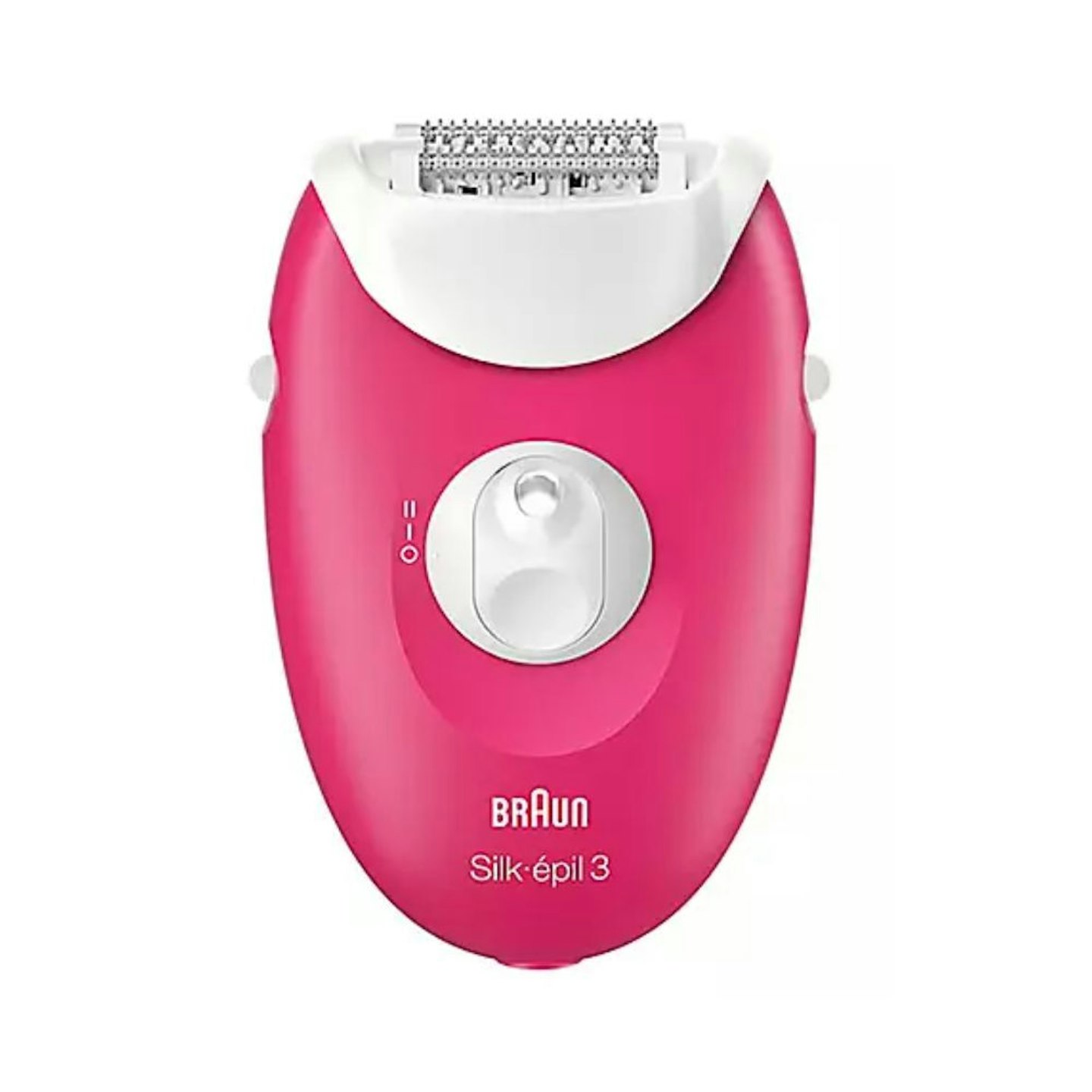 Braun
BraunThink of the Braun Silk-Epil 3 3-410 Epilator as the budget-friendly little multitasker that actually pulls its weight. With three heads (epilator, shaver, trimmer/comb), it’s basically an all-in-one hair removal kit dressed in pink. Knees, underarms, or those impossible-to-reach spots? Covered. Forget razor burn and waxing strips, this Braun bestie one promises smooth skin that lasts weeks, not days.
What do users say, you ask? It's beginner-friendly, effective, and doesn’t empty your wallet. The 20-tweezer system + SmartLight combo snags the sneaky hairs, and reviews love that touch-ups stretch for weeks. It’s easy to hold, lightweight, and, honestly, way better than battling with razor bumps. But, let's be real, it's no spa-day luxury. It's loud, not cordless and for strictly dry use. Overall, it’s not the fastest or quietest, but for the price? Solid. Smooth skin for weeks, if you can put up with a little ouch.
Pros
- Removes hair effectively, even fine ones (sometimes takes a few passes)
- Lightweight and easy to hold makes it beginner-friendly
- Not spa-day luxury but great value - cheap but gets the job done
- Results last weeks and SmartLight is genius for catching tiny hairs
Cons
- Loud (more hair clipper than whisper)
- Corded only, no wet use
- Comes with a 2-pin plug (UK users may need an adapter)
- 20-tweezer system for longer regrowth times.
- SmartLight to spot fine hairs.
- Massage rollers to ease the sting.
- Two speed settings: gentle or efficient.
- Corded design - no battery worries, no cordless freedom.
Epilator FAQs
Does epilating hurt?
The idea of epilating is daunting, mostly due to how painful it sounds and, well, is. But if you're used to plucking your eyebrows and can now say that the pain is bearable… epilating is the same. The more you do it, the more you become used to the pain. But the first few times can definitely be a touch eye-watering. Youch.
What are the benefits of epilating, and how long does epilation last?
The most notable benefit of epilation is that the hair will grow back more slowly and finer. Epilation offers a long-term hair removal solution, giving you hair-free skin for up to four weeks. Another benefit of epilation is that it's fuss-free and not as messy as waxing. You can do it at home at a time that suits you, and you can also purchase epilators to use in the shower.
Can you epilate facial hair?
You can use an epilator on your face, but as the skin on the face is incredibly sensitive, it may cause irritation. Not to mention the pain is quite intense. But, if you take all the right steps and remember to pull the skin taut, you can also achieve a smooth, hairless finish on your face.
Can you epilate underarms?
Your underarms are a great place to build up tolerance to epilating, as after a while, you'll find you are hairless for weeks under there - how luxurious would that be to have no stubble, especially in the summer months? It can be tricky to get the right angle when tackling armpits, so you will have to hold the epilator at different degrees and pull the skin around to catch all the hair.
Can you epilate legs?
Absolutely! The legs - especially below the knee - are the most common place people epilate, and continuous epilating will see amazing results. Plus, you can quite quickly build up a strong tolerance to the pain in your legs.
Can you epilate the bikini line?
Yes! It may be tricky and painful to begin with, but the bikini area is where most women want to stunt hair growth, as shaving can cause complications and isn't long-lasting. Remember also to exfoliate this area whenever you can, as it is easier to get ingrown hair if not careful, which could then lead to infection.
How do you epilate?
If you've epilated before, you'll know that it is quite painful, depending on your hair type and pain threshold. (Note: an empty house, some loud music and a glass of wine is a setup that shouldn't be overlooked if you're a newbie.)
If you're new to epilating, you should follow these steps to make it as pain-free as possible:
Before epilating
1. Find the right epilator for you:
There are many different epilators available on the market to suit different budgets and different areas of hair. Make sure you invest in one that is good quality.
2. Exfoliate:
Exfoliation is the key to successful hair removal, whatever the method. It removes dead skin cells, smooths skin and, most importantly, fights against ingrown hairs by promoting that the hair regrows in the correct direction. Exfoliate using a loofah, exfoliating gloves or an in-shower body scrub, and massage the skin in circular motions. You should do this before you are due to remove any hair, but it's good practice to exfoliate every time you wash.
3. Soak in warm water:
Just like waxing, if you bathe or shower before you are due to remove body hair, it will be less painful because the hair follicles will be looser and the hairs will come out more easily.
Whatever your ablution of choice, try and soak in water as hot as you can stand - and without irritating or damaging the skin - for at least 10 minutes.
If it’s your first time trying this method, purchase an epilator which can be used in the shower, as the warm water opens pores, which loosen the hair follicles so they are removed easily.
4. Dry the skin:
After you've washed, your skin should be free of dirt, lotions and moisturisers. Dry your skin thoroughly with a towel, and try pulling the towel in the opposite direction of hair growth so the hairs stand up. The drier the hair is, the easier it'll be for the epilator to catch them the first time.
During epilating
1. Find somewhere comfortable to sit:
Put some time aside in your day and find somewhere comfortable to sit - it may take a while, especially if you're a rookie, because you'll be taking lots of breaks to manage the pain. It's also advisable to epilate in the evening as your skin will be red and bumpy afterwards - but will be looking smooth by morning.
2. How to use the epilator:
Don't start at your ankles, as they're the most painful place on your leg. Start on the lower leg on the lowest setting, and pull the skin taut to help the epilator pick up hair.
Move the epilator in circular motions over your skin, stopping when necessary, and you'll start to see the magic instantly.
Your skin will quickly get used to the sensation of the epilator, and you will be able to tackle trickier areas.
Don't be too ambitious on your first go; ease yourself into it. Also, it is common to draw a little blood on the first go, but don't be too put off.
After epilating
Be prepared for your skin to resemble that of a plucked chicken, and make sure you don't lather on any scented lotions or creams onto the freshly-epilated skin, as they will irritate it. Try using a lotion with aloe vera, as this will soothe the skin.
By this point, you may be thinking, 'as if I'm putting myself through that again,' but the results may just sway you to keep going, and each time you do it, it becomes easier, quicker and less painful.
If you're serious about decreasing hair regrowth, epilate the same area every day for one week, and then begin doing it weekly. You will see great results and eventually will only need to epilate monthly.
Piper Huxley is a Life and Style Product Writer, specialising in fashion, beauty and interior design. When she’s not obsessing over the latest home decor trends, she’s doomscrolling somewhere online.
